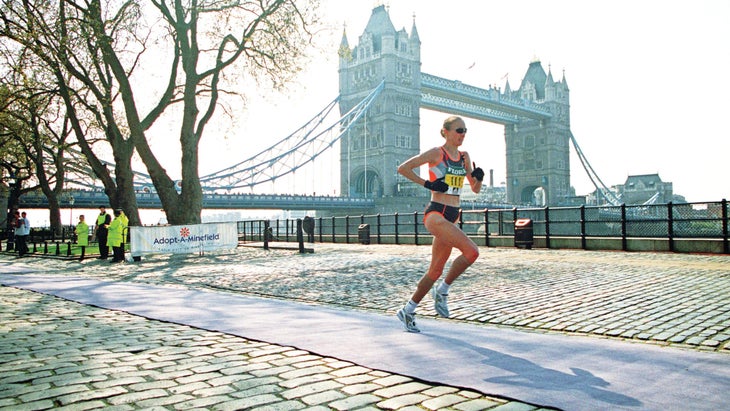Have a question?聽Shoot us a note and a PodiumRunner expert will answer.
Question:
I recently read your explanation of . Can you now share training programs that can improve aerobic capacity? Can you do it on an elliptical, stationary bike, while weightlifting, etc.?
Author and Coach Matt Fitzgerald Answers:
Whenever I am asked a question of this sort, I respond initially with a question of my own: Why? In this case: Why do you want to improve your aerobic capacity? My hunch is that you want to do so to improve your running performance. If this hunch is correct, then what you really want is a training program that will improve your running performance, not one that improves your aerobic capacity only.
Performance is Multi-faceted
This clarification is important, because running performance has numerous physiological contributors, of which aerobic capacity is just one. Too often, runners fixate on a single contributor, mistaking the means for the end, hence training in a one-sided manner that yields less improvement than would a more well-rounded program that addresses all of the important puzzle pieces.
One example is fat burning. The ability of the muscles to burn fat at a high rate is also a valuable contributor to running performance. But it鈥檚 not the be-all and end-all. The most effective way to of the muscles is to do a lot of long, slow runs and eat a high-fat, low-carbohydrate diet. But research indicates that such an unbalanced program is not the best way to improve overall running performance, as it compromises certain other aspects of fitness even as it enhances fat burning.
Another example is weight management. It is well established in the scientific literature that a low body weight and a lean body composition are associated with superior running performance. But this does not mean that shedding body fat is beneficial at any cost. Runners commonly sabotage their own performance by fixating on weight and trying to lose it too quickly or in risky ways, which can lead to problems such as poor recovery, loss of muscle mass, and nutrient deficiencies.

Speed Works, But Only So Far
Getting back to your question of aerobic capacity: Studies have shown that, in beginners, a training program based on high-intensity intervals (at paces at or faster than you can sustain for 8 minutes all-out) boosts aerobic capacity more quickly than a less-intense regimen. by French researchers, for example, found that when previously sedentary individuals completed eight weeks of thrice-weekly interval workouts, their VO2max increased by almost double the amount that it did after eight weeks of training exclusively at moderate intensity.
The training mistake you鈥檙e most likely to make if you focus too narrowly on VO2max is doing too much work at high intensity and not enough at low intensity. High-intensity interval training only gets you so far. Studies involving athletes who have already developed a fitness based see the biggest gains in aerobic capacity when they combine a lot of low-intensity training with a modest amount of work high-intensity. In published in Frontiers in Physiology in 2014, endurance athletes who trained at high volume and did just 26 percent of their work at high intensity for nine weeks experienced an 11.7 percent increase in VO2max, whereas athletes who trained at lower volume and spent 57 percent of their exercise time at high intensity for nine weeks gained a mere 4.8 percent in aerobic capacity. (Other research indicates that even better results follow when high-intensity training time is limited further, to around 20 percent of the total.)
One Piece of the Performance Puzzle
No matter how you train, you can鈥檛 keep increasing your aerobic capacity forever. But that鈥檚 not important, because you can continue to improve what really matters鈥攑erformance鈥攍ong after your VO2max has hit a ceiling. Consider Paula Radcliffe, the former marathon world record holder, whose VO2max was tracked throughout her illustrious career. By age 17, Radcliffe was able to consume oxygen at an astonishing rate of 72.8 ml/kg/min. Her aerobic capacity barely budged thereafter, yet her race times improved steadily for years to come, and when she set the last of her world records at age 31, her VO2max was actually 诲辞飞苍听slightly to 70.0 ml/kg/min. This pattern is quite normal in high-level runners, and it鈥檚 proof that, like fat burning, body weight and other factors, VO2max is just one piece of fitness puzzle.

Having said all of this, I will add that the most effective way to train for increased aerobic capacity in the longer term happens to identical to the most effective way to train for better all-around performance. In the 2014 study I mentioned above, the athletes who trained at high volume and did most of their training at low intensity not only saw bigger increases in aerobic capacity鈥攃ompared to those who trained less, yet more intensely鈥攂ut they also recorded larger performance gains in a time-to-exhaustion test.
Same Principle, Different Activities
The same principle applies to all aerobic exercise modalities, from running to cycling to working out on an elliptical trainer. If you want to maximize your aerobic capacity and performance in any of these disciplines, you should train a lot (relative to your personal limits) and spend about 20 percent of your exercise time at high intensity, the rest at low intensity. Weightlifting and other forms of strength training, however, are not as effective in developing aerobic capacity, but they do contribute to running performance in other ways.


